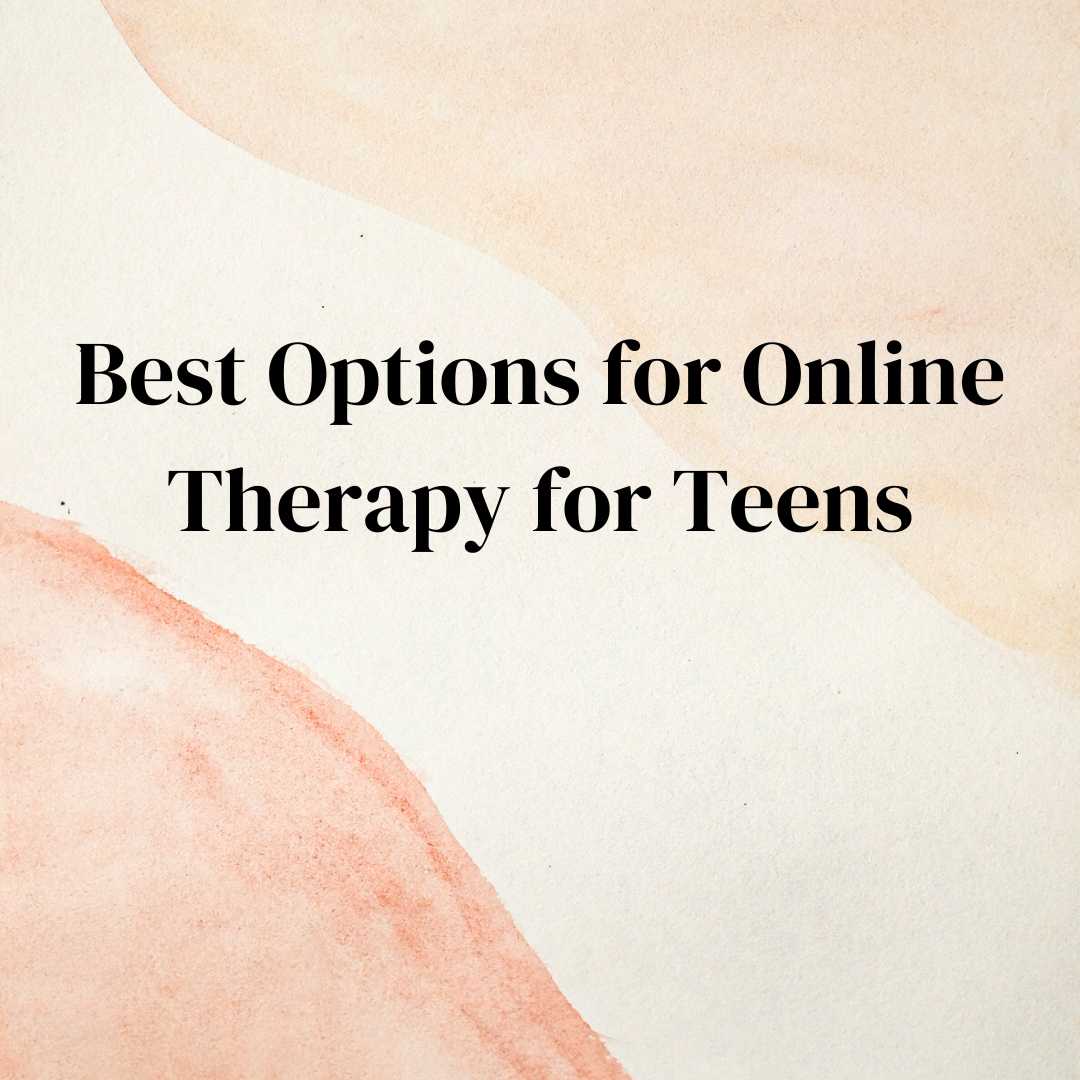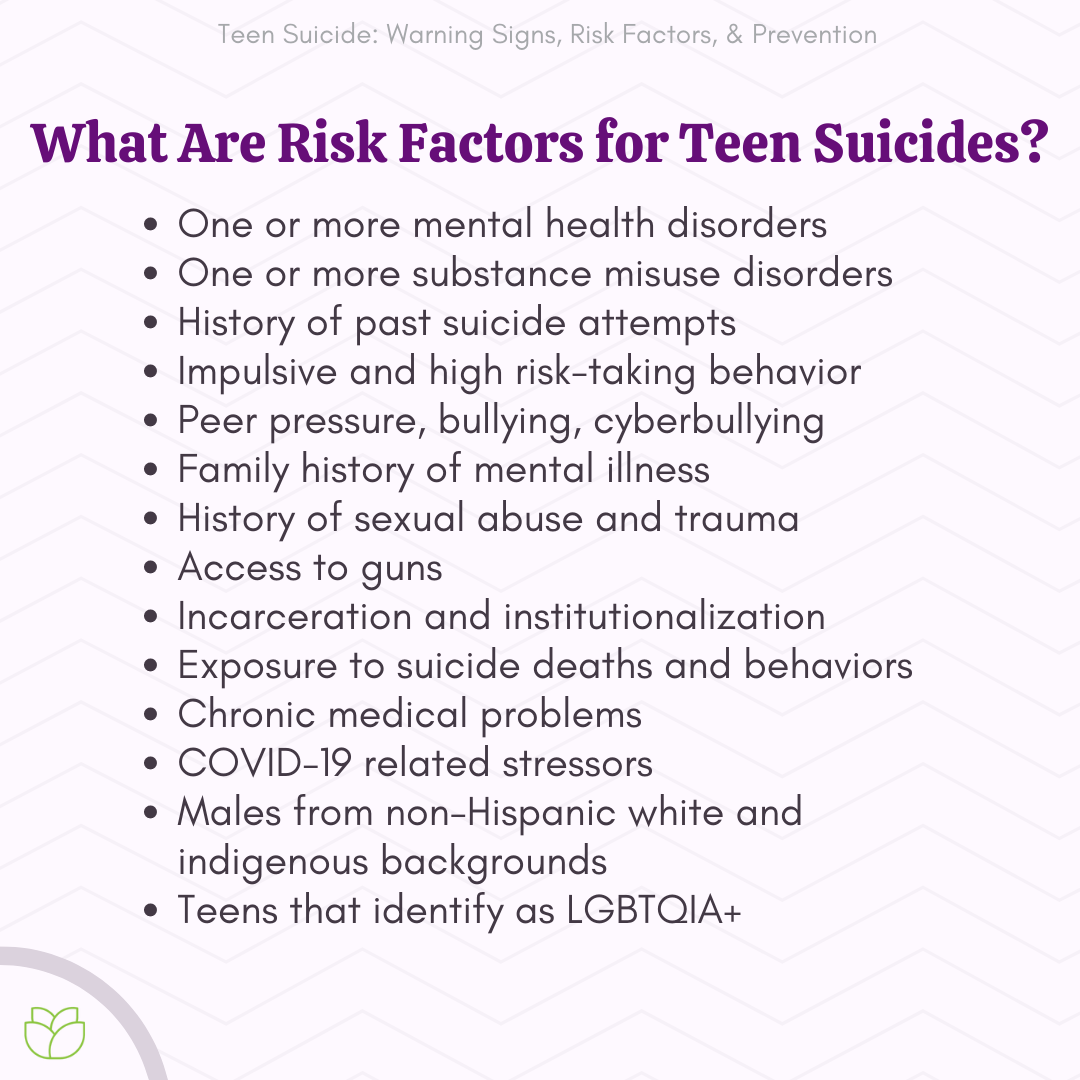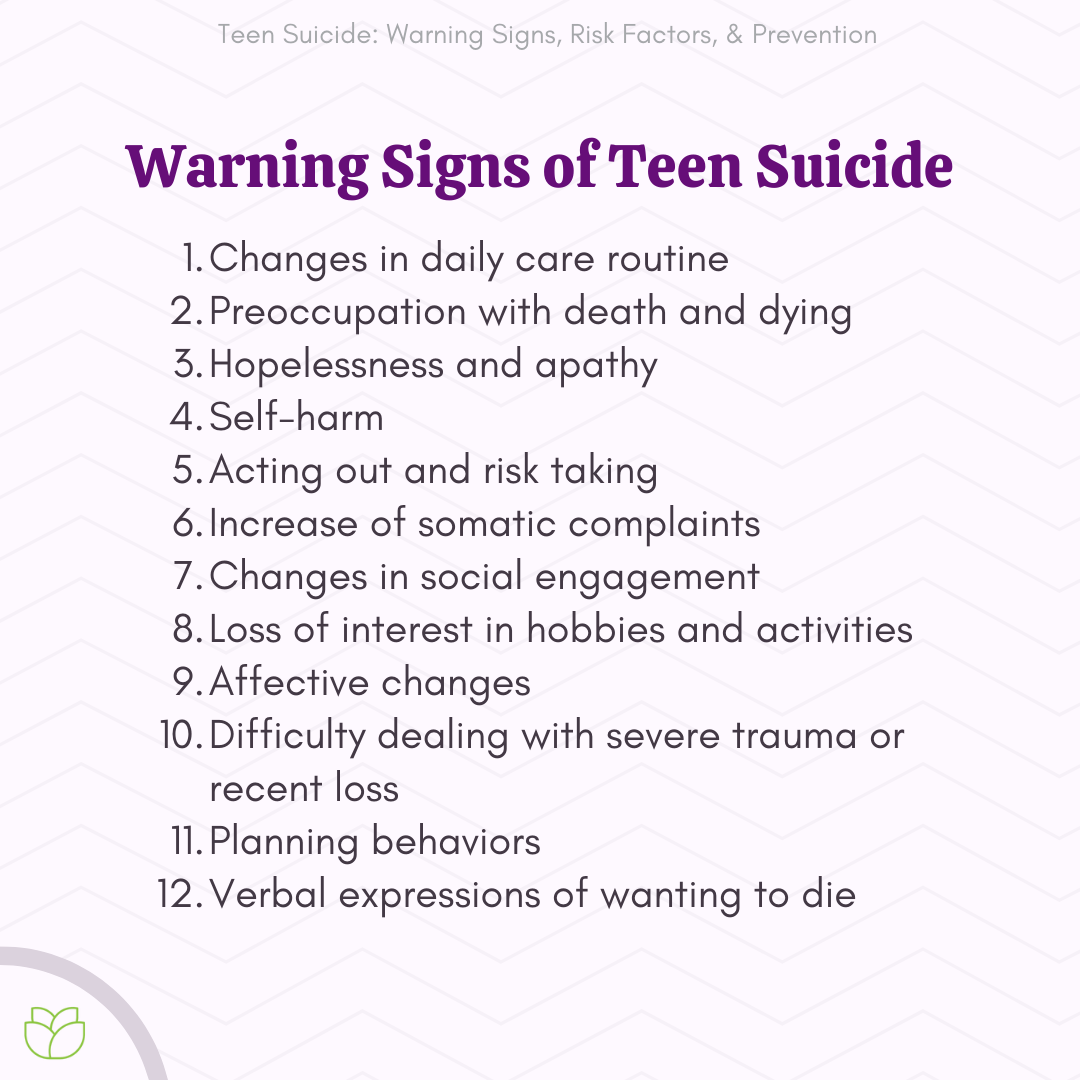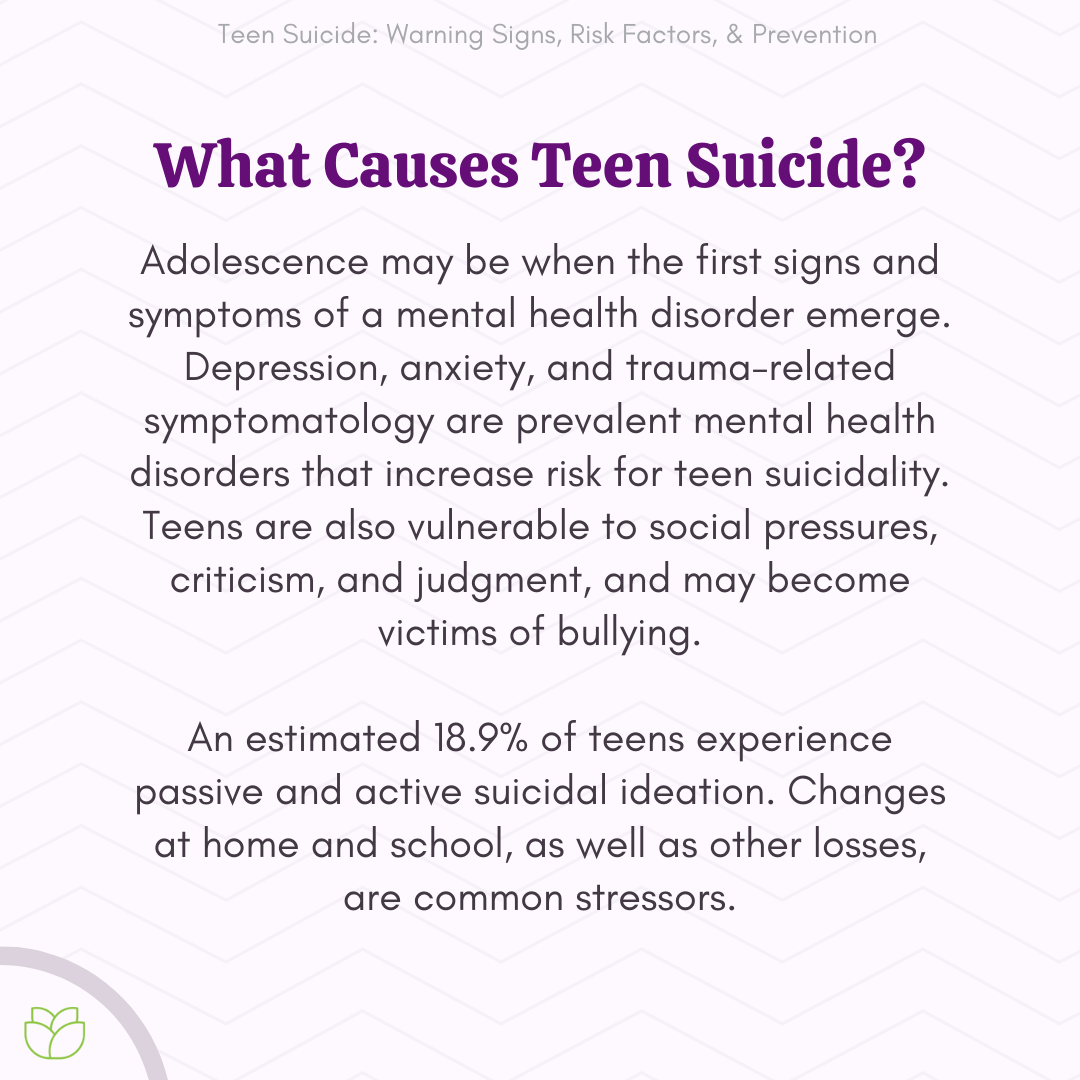Teen suicide is a national health crisis and the second leading cause of death in individuals aged 12 to 18 years old.1 Understanding how to identify when someone is experiencing suicidal thoughts, feelings, and behaviors and provide resources for mental health treatment are effective ways to support teens experiencing suicidal ideations.
Therapy Once Per Week Isn’t Always Enough Charlie Health’s virtual mental health program includes curated peer groups, individual therapy, and family therapy for teens and young adults with serious mental health issues. Insurance accepted. Learn More
What Causes Teen Suicide?
Adolescence may be when the first signs and symptoms of a mental health disorder emerge. Depression, anxiety, and trauma-related symptoms are prevalent mental health disorders that increase risk for teen suicidality. Teens are also vulnerable to social pressures, criticism, and judgment, and may become victims of bullying.2,3
An estimated 18.9% of teens experience passive and active suicidal ideation.3 These thoughts can bring shame and negative feelings, making it difficult for them to reach out for help. Teen boys are more at risk for death by suicide; however, teen girls make more attempts.1 This is due to the lethality of means more often chosen by boys vs. girls.1,4
Changes at home such as moving and divorce are common stressors that increase a youth’s risk. At school, changes in friendships and problems academically may also increase risk for mental health disorders and subsequent suicide risk. Other losses such as death of a family member or peer cause substantial distress and may increase thoughts of wanting to die by suicide.
12 Warning Signs of Teenage Suicide
Early identification and support of youth at risk for suicide is the best way to mitigate suicide attempts and behaviors. Many of the warning signs for suicide that indicate a teen is vulnerable are consistent across age groups; however, indicators most commonly found in adolescence include changes in daily care routine, preoccupation with death and dying, and hopelessness, worthlessness and apathy.
Here are twelve warning signs for suicide in teens:
-
- Changes in daily care routine: When a teen’s sleep, appetite, and hygiene suddenly change, this may signal an issue. Changes from baseline behavior are an early indicator of mental health distress and increased risk for teenage suicidal thoughts, feelings, and behaviors.5,6
- Preoccupation with death and dying: A youth struggling with suicidal thoughts may become preoccupied with topics related to death and dying. They may not personalize the topics but show a sudden interest in mortality.5
- Hopelessness and apathy: The teen may express hopelessness and futility about the future. They may also stop making plans for the future and seem indifferent to praise and goals they once had.4
- Self-harm: Engaging in non-suicidal self-injury increases risk and capability for teen suicide. Self-harm may be hitting, burning, cutting oneself and efforts are often made to conceal nonsuicidal self-injury (NSSI) behavior.3
- Acting out and risk taking: The teen may start engaging in high-risk behaviors such as substance misuse, risky sexual behavior, delinquency, and aggressive behaviors.5
- Increase of somatic complaints: Physical health is impacted by mental health distress and teens vulnerable to suicide may show an increase in headaches, stomach problems, and fatigue.5
- Changes in social engagement: The teen may withdraw from friends and family or display signs ofangst. Increase in social isolation further worsens mental health distress and suicide risk.5
- Loss of interest in hobbies and activities: The teen may stop participating in sports, hobbies, and interests with no reason as to why.5
- Affective changes: The teen may suddenly appear depressed or anxious and show less positive mood states. They may become indifferent to praise and positive news. Becoming suddenly cheerful after a long period of depressed mood is also a sign that they’ve decided to die.5
- Difficulty dealing with severe trauma or recent loss: When a teen has something traumatic occur or experiences a loss, they may experience difficulty processing, a desire to want to be treated as before, and feelings of isolation from their peers.7
- Planning behaviors: The teen may start to give away possessions, write suicide notes, and even make statements of wanting to die.5
- Verbal expressions of wanting to die: The teen may make statements about wanting to die or not being around much longer. Or warn loved ones about what to do if something were to happen to them.5
Charlie Health - Virtual Therapy For Teens & Young Adults Charlie Health’s virtual mental health program includes curated peer groups, individual therapy, and family therapy for teens and young adults with serious mental health issues. Insurance accepted. Learn More Do you or someone in your life have suicidal ideation? Grow Therapy enables you to find a psychiatrist or psychiatric nurse practitioner who can diagnose your condition, prescribe appropriate medications, and monitor your reaction to medication. Accepting most major insurances. Find A Provider
What Are Risk Factors for Teen Suicides?
Understanding risk factors can help family and friends in early identification and suicide prevention efforts. This knowledge also assists medical and mental health providers in accurate screenings and risk assessment. Risk factors are often conceptualized by if they’re inherent risks, commonly called static risk factors. These include race, history of attempt, and family mental health history.
Dynamic risk factors can be altered and subsequently change the level of risk when attended to. These include access to means, peer group, and engagement in treatment.5,8
Risk factors for teen suicides include:
- One or more mental health disorder
- One or more substance misuse disorder
- History of past suicide attempts
- Impulsive and high risk-taking behavior
- Peer pressure, bullying, cyberbullying (on social media)
- Family history of mental illness, substance abuse, and suicide
- Recent losses of a loved one
- History of sexual abuse and trauma
- Access to guns
- Incarceration and institutionalization
- Recent release from inpatient hospitalization
- Exposure to suicide deaths and behaviors from peers, family, and media
- Chronic medical problems or recent diagnosis of a medical problem
- Traumatic brain injury
- COVID-19 related stressors such as changes to school and social routine
- Males from non-Hispanic white and indigenous backgrounds
- Teens that identify as LGBTQIA+
What to Do If You Suspect Your Teen Is Suicidal
If your child is showing signs and symptoms acute mental distress or teenage suicidal thoughts, feelings, and behaviors, start an open discussion about mental health distress and suicide. Express your unconditional support and validation of their feelings.10 Determine whether there is imminent risk to their safety, which often presents as having a plan and desire to die.8,9
If you’re unsure of the imminence of risk or want to have your child evaluated by a mental health professional, you have several options. First, find the right therapist through an online therapist directory. Consider enrolling your child in teen counseling. You could also call the National Suicide Hotline number, your local crisis number, or a mobile crisis team.
In case of imminent risk or an interrupted attempt, you may need to call law enforcement or emergency medical services; however, when appropriate, it’s the safest and least traumatizing option to utilize outpatient options. Understanding the resources in your community and what situations they’re best used for is vital to the prevention of teen suicide.8,11
FOR IMMEDIATE HELP CALL: The Suicide Hotline: 988
Do you or someone in your life have suicidal ideation? Grow Therapy enables you to find a psychiatrist or psychiatric nurse practitioner who can diagnose your condition, prescribe appropriate medications, and monitor your reaction to medication. Accepting most major insurances. Find A Provider
How Parents Can Support a Suicidal Teen
As a parent or caregiver, educating yourself on the signs of suicide risk and associated risk factors will help you prevent death by suicide. It is also important to help foster healthy and adaptive practices for your teen as these are protective factors that help minimize suicide risk.
Six tips for teen suicide prevention include:
1. Be Tuned In to Your Child’s Activities
Parents should be tuned into their children’s activities online and outside of the home. When their child is struggling, provide extra care and support. Discuss your child with teachers, coaches, and others close to the teen for insight and additional monitoring if needed. It may help to identify negative influences in the teen’s life or areas to improve behaviorally and emotionally.10
2. Restrict Access to Means
Means restriction may be required if your teen has a prior suicide attempt or is at high risk for suicide. This could mean preventing access to firearms, medications, alcohol, or any other means that could contribute to suicide capability.12
3. Help Your Teen Be Adherent to Medical & Mental Health Treatment
It’s important to help your teen with consistent medication management and regular attendance to health and behavioral health appointments. Parents often have control over transportation and financial means and are vital to treatment adherence. They should monitor the teen for healthy sleep, diet, and regular exercise.13
4. Have Open Communication
Parents should also have frank, non-judgmental discussions about mental health, suicidality, and NSSI with their children to help foster honest communication and mitigate shame around such topics. This may also strengthen the relationship between the teen and parent, which is a protective factor in preventing suicide.10 Also, encourage your teen to talk to their therapist about their suicidal thoughts and discuss any possible concerns they may have about disclosing this information to their therapist.
5. Model Healthy Behaviors
One of the most powerful things parents can do is to model healthy behaviors, such as adaptive coping skills, positive interpersonal relationships, and attendance to physical and mental health needs. Embody the behaviors you want to see in your child.13
6. Educate Yourself About the Differences Between Suicidal Ideation, Suicidal Behaviors, & Nonsuicidal Self-Injury (NNSI)
These three things can have distinct behavioral functions and associated risks for different teens.14 Ideation for one teen may be a frequent symptom of rumination but not necessarily signal imminent risk; whereas for another teen, ideation may be far from their baseline behavior, and signal a need for immediate intervention.
NSSI also doesn’t always signal that a teen is suicidal, but it can increase their risk and capability for future attempts.14 Having honest conversations with your teen will help to elucidate their current symptoms and risks.
Final Thoughts on Teenage Suicide Prevention
Parents and those involved in the life of a teen have powerful influence to mitigate teen suicide risk and having knowledge of evidence-based suicide prevention methods and interventions is foundational; however, nothing is as important as listening to the teen and providing genuine love and support.
To help our readers take the next step in their mental health journey, Choosing Therapy has partnered with leaders in mental health and wellness. Choosing Therapy is compensated for marketing by the companies included below. Virtual Therapy For Teens & Young Adults Charlie Health’s virtual mental health program includes curated peer groups, individual therapy, and family therapy for teens and young adults with serious mental health issues. Insurance accepted. Learn More Online Psychiatry Grow Therapy enables you to find a psychiatrist or psychiatric nurse practitioner who can diagnose your condition, prescribe appropriate medications, and monitor your reaction to medication. Accepting most major insurances. Find A Provider Depression Newsletter A free newsletter from Choosing Therapy for those impacted by depression. Get helpful tips and the latest information. Sign UpAdditional Resources
For Further Reading
- Best Books About Suicide
- Suicide Statistics, Awareness, and Resources for Prevention
- National Suicide Prevention Lifeline for teens and LGBTQ+
- National Suicide Prevention Lifeline for Teens
- The Trevor Project
- American Foundation for Suicide Prevention
- CDC: Suicide Prevention
- Teen Counseling Service Review
- Books About Self-Harm
- Movies About Suicide
OCD in Teens: Signs, Symptoms, and Treatment OCD symptoms are hard enough on fully developed adults—but what about teens who begin to exhibit signs and symptoms of obsessive-compulsive disorder (OCD) just as they’re growing into their individualism and sense of self? Unfortunately, that’s the way it is for many, as OCD most commonly develops in teen and adolescent years.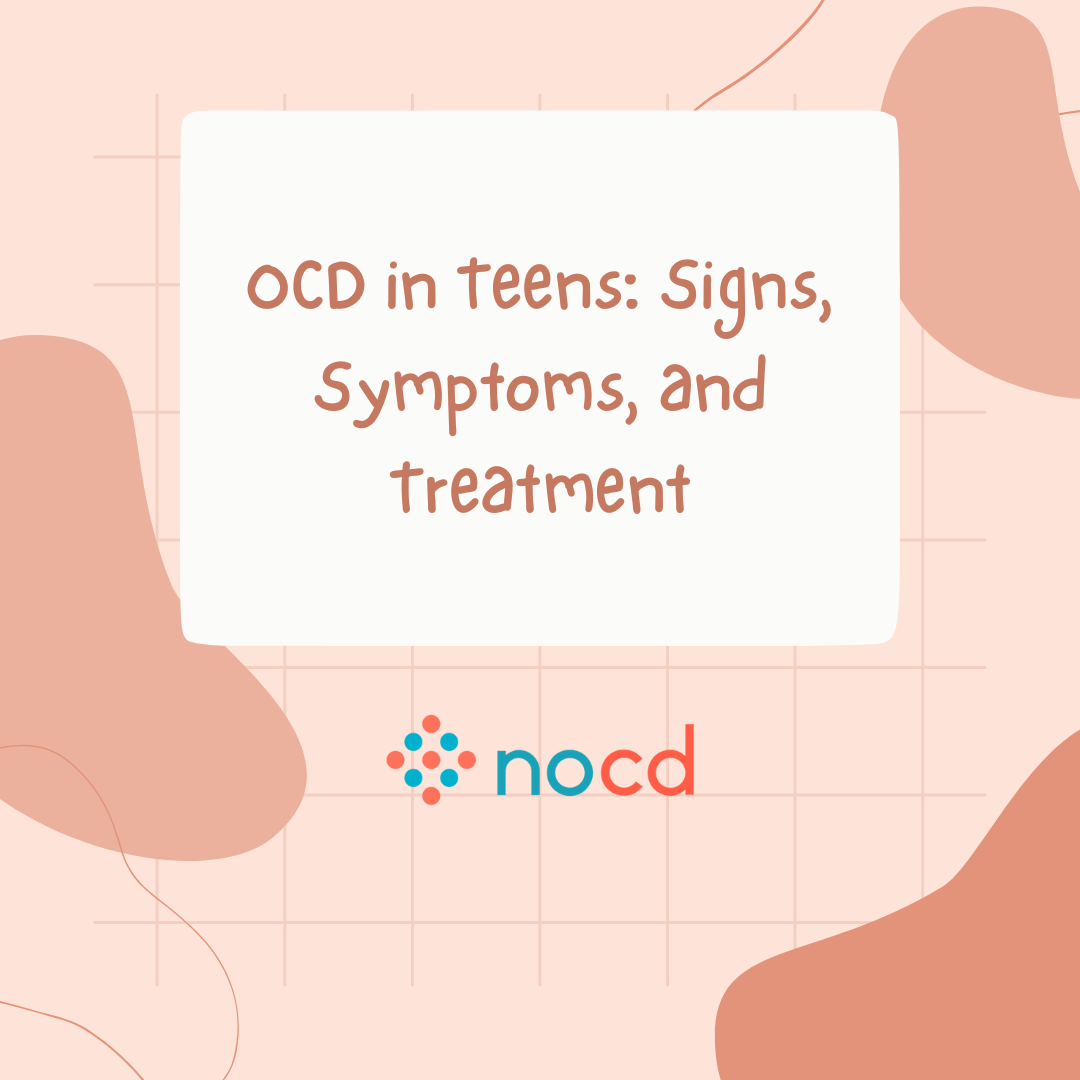
Best Options for Online Therapy for Teens With so many truly amazing online therapy options for teens, choosing one can be difficult. Some of the most important factors to consider before selecting a company are your budget, who takes your insurance, which ones can answer your questions, and most importantly, who your teen likes the best. Supporting and listening to your teen is crucial for a successful therapy experience.